Podcast
Questions and Answers
What is one of the primary reasons cells compartmentalize their internal structures?
What is one of the primary reasons cells compartmentalize their internal structures?
- To segregate different microenvironments for efficiency (correct)
- To increase the rate of apoptosis
- To enhance genetic mutation rates
- To decrease the size of the cell
Which structure is NOT part of the endomembrane system?
Which structure is NOT part of the endomembrane system?
- Mitochondria (correct)
- Golgi body
- Peroxisomes
- Nuclear membrane
What is a necessary feature for proteins to be imported into the nucleus?
What is a necessary feature for proteins to be imported into the nucleus?
- A nuclear localization signal (NLS) with positively charged amino acids (correct)
- A signal sequence rich in hydrophobic amino acids
- A glycosylation modification on the protein
- A phosphorylation group to enhance import efficiency
How do compartments within the endomembrane system primarily communicate with each other?
How do compartments within the endomembrane system primarily communicate with each other?
Which statement about sorting signals is accurate?
Which statement about sorting signals is accurate?
What role does the nuclear import receptor (NIR) play in cellular transport?
What role does the nuclear import receptor (NIR) play in cellular transport?
What is the primary energy source required for the nuclear import process?
What is the primary energy source required for the nuclear import process?
How do proteins enter the mitochondria?
How do proteins enter the mitochondria?
What happens to proteins once they are inside the mitochondrial matrix?
What happens to proteins once they are inside the mitochondrial matrix?
What is the fate of proteins after they enter the endoplasmic reticulum (ER)?
What is the fate of proteins after they enter the endoplasmic reticulum (ER)?
What initiates the process of protein translocation into the endoplasmic reticulum?
What initiates the process of protein translocation into the endoplasmic reticulum?
What role do chaperones play in the endoplasmic reticulum?
What role do chaperones play in the endoplasmic reticulum?
What is the primary function of adaptins during vesicle formation?
What is the primary function of adaptins during vesicle formation?
Which sequence of events occurs first during the transport of proteins from the ER to the Golgi apparatus?
Which sequence of events occurs first during the transport of proteins from the ER to the Golgi apparatus?
Which protein is primarily involved in the pinching off of vesicles from the membrane?
Which protein is primarily involved in the pinching off of vesicles from the membrane?
What type of transport does exocytosis refer to in the endomembrane system?
What type of transport does exocytosis refer to in the endomembrane system?
Which protein coating mechanism helps promote membrane curvature during vesicle budding?
Which protein coating mechanism helps promote membrane curvature during vesicle budding?
What are sorting signals primarily made of?
What are sorting signals primarily made of?
What is the role of the nuclear import receptor (NIR) during protein translocation into the nucleus?
What is the role of the nuclear import receptor (NIR) during protein translocation into the nucleus?
What is required for proteins to successfully enter the mitochondria?
What is required for proteins to successfully enter the mitochondria?
What is the main purpose of compartmentalization in cells?
What is the main purpose of compartmentalization in cells?
What occurs to the mitochondrial signal sequence after successful translocation into the mitochondrial matrix?
What occurs to the mitochondrial signal sequence after successful translocation into the mitochondrial matrix?
During protein transport into the endoplasmic reticulum (ER), what determines if a protein becomes soluble or transmembrane?
During protein transport into the endoplasmic reticulum (ER), what determines if a protein becomes soluble or transmembrane?
What type of signal directs proteins to their specific organelle in the endomembrane system?
What type of signal directs proteins to their specific organelle in the endomembrane system?
What characteristic of the nuclear envelope facilitates the transport of molecules?
What characteristic of the nuclear envelope facilitates the transport of molecules?
What role do chaperone proteins play after a protein has entered the mitochondrial matrix?
What role do chaperone proteins play after a protein has entered the mitochondrial matrix?
Which of the following statements about the endomembrane system is accurate?
Which of the following statements about the endomembrane system is accurate?
Which sequence best describes the movement of proteins into the nucleus?
Which sequence best describes the movement of proteins into the nucleus?
What is the role of the signal recognition particle (SRP) in the process of protein translocation into the endoplasmic reticulum?
What is the role of the signal recognition particle (SRP) in the process of protein translocation into the endoplasmic reticulum?
What is the function of clathrin during vesicle formation?
What is the function of clathrin during vesicle formation?
Which statement accurately describes the interaction of adaptins during vesicle formation?
Which statement accurately describes the interaction of adaptins during vesicle formation?
What happens to the signal recognition particle after it interacts with the SRP receptor in the ER membrane?
What happens to the signal recognition particle after it interacts with the SRP receptor in the ER membrane?
What characterizes the transport of proteins in an outward direction from the ER?
What characterizes the transport of proteins in an outward direction from the ER?
Which molecule is involved in pinching off the vesicle from the membrane during vesicle formation?
Which molecule is involved in pinching off the vesicle from the membrane during vesicle formation?
How does the endoplasmic reticulum ensure that the channel remains open during the translation of the protein?
How does the endoplasmic reticulum ensure that the channel remains open during the translation of the protein?
What process is primarily responsible for transporting proteins from the plasma membrane to lysosomes?
What process is primarily responsible for transporting proteins from the plasma membrane to lysosomes?
Flashcards
Cellular Compartmentalization
Cellular Compartmentalization
Dividing a cell into specialized compartments (like organelles) to increase efficiency, complexity, and reaction rates.
Endomembrane System
Endomembrane System
A network of membranes within a eukaryotic cell, including the nuclear envelope, ER, Golgi, peroxisomes, endosomes, and lysosomes. They communicate via vesicles.
Protein Sorting Signals
Protein Sorting Signals
Specific amino acid sequences that direct proteins to their correct cellular destination.
Nuclear Localization Signal (NLS)
Nuclear Localization Signal (NLS)
Signup and view all the flashcards
Membrane Trafficking (Vesicles)
Membrane Trafficking (Vesicles)
Signup and view all the flashcards
Nuclear Import Receptor (NIR)
Nuclear Import Receptor (NIR)
Signup and view all the flashcards
Mitochondrial Protein Import
Mitochondrial Protein Import
Signup and view all the flashcards
Mitochondrial Signal Sequence
Mitochondrial Signal Sequence
Signup and view all the flashcards
Protein Translocation (Mitochondria)
Protein Translocation (Mitochondria)
Signup and view all the flashcards
ER as Entry Point
ER as Entry Point
Signup and view all the flashcards
Protein translocation into ER
Protein translocation into ER
Signup and view all the flashcards
Signal Recognition Particle (SRP)
Signal Recognition Particle (SRP)
Signup and view all the flashcards
Secretory pathway
Secretory pathway
Signup and view all the flashcards
Exocytosis
Exocytosis
Signup and view all the flashcards
Vesicle formation
Vesicle formation
Signup and view all the flashcards
Adaptins
Adaptins
Signup and view all the flashcards
Protein folding in ER
Protein folding in ER
Signup and view all the flashcards
Sorting signals
Sorting signals
Signup and view all the flashcards
Why Compartmentalize?
Why Compartmentalize?
Signup and view all the flashcards
Transport via Vesicles
Transport via Vesicles
Signup and view all the flashcards
NLS Recognition
NLS Recognition
Signup and view all the flashcards
GTP-powered Transport
GTP-powered Transport
Signup and view all the flashcards
Mitochondrial Protein Unfolding
Mitochondrial Protein Unfolding
Signup and view all the flashcards
ER signal sequence
ER signal sequence
Signup and view all the flashcards
SRP receptor
SRP receptor
Signup and view all the flashcards
Protein translocator
Protein translocator
Signup and view all the flashcards
Study Notes
Membrane Trafficking
-
Cellular Compartmentalization: Cells compartmentalize to increase complexity, size, efficiency of reactions, and reduce the distance molecules must travel. Different microenvironments are established in specialized regions.
-
Endomembrane System: A group of organelles involved in protein processing and transport. Includes nuclear membrane, endoplasmic reticulum (ER), Golgi body, peroxisomes, endosomes, and lysosomes. All these compartments communicate via vesicles derived from membrane invaginations. They tend to have more oxidized environments than the cytosol.
-
Organelle Communication: Compartments communicate via vesicles, which bud off from one membrane and fuse with another. These vesicles originate from membrane invaginations. Vesicles transport materials and maintain the compartments' unique environments (some compartments have more oxidizing environments).
-
Protein Transport: Proteins move to specific compartments via different mechanisms:
- Membrane pores: Allow passage of specific proteins
- Across the membrane bilayer: Proteins can be transported across the lipid bilayer.
- Vesicles: Proteins are transported within vesicles.
-
Sorting Signals: Amino acid sequences, typically 50-60 amino acids long, direct proteins to specific organelles.
Nuclear Envelope
- Double Membrane: The nuclear envelope consists of two membranes.
- Inner membrane: Binds nuclear proteins.
- Outer membrane: Continuous with the endoplasmic reticulum (ER).
Nuclear Pores
- Transport mechanism: Proteins or molecules intended for import into the nucleus must traverse the nuclear pore complex.
- NLS: Nuclear localization signals are short sequences (lysine and arginine rich) that direct proteins for import.
- Import Receptor (NIR): Proteins are imported using a receptor (NIR), this process requires energy in the form of GTP.
- GTP involvement: GTP is necessary for the import receptor to bind the protein and for the transport process.
- Post-import: The protein and NIR separate inside the nucleus, freeing the protein inside the nucleus; the import receptor returns to the cytosol.
Transport into Mitochondria
- Double Membrane: Mitochondria have a double membrane. Proteins generally need to unfold to pass through both membranes.
- Signal Sequence: A signal sequence (end terminal) allows translocation across membranes simultaneously at specialized contact sites between the membranes. This allows it to pass simultaneously through both membranes.
- Import Receptor: Protein translocation occurs via an import receptor that coordinates protein translocators. The import receptor is on the outer membrane and guides the protein.
- Chaperone proteins: Chaperone proteins help maintain protein integrity and prevent the protein from reverting back out of the mitochondria.
Transport Into ER
- Signal Recognition Particle (SRP): The signal recognition particle (SRP) on ribosomes temporarily halts protein synthesis, binds the signal sequence, and directs it to the ER membrane.
- Protein Translocator: The signal sequence targets the protein to a protein translocator in the ER membrane.
- Protein Synthesis on ER: Some proteins are translated while attached to the ER. The ER signal sequence facilitates translocation.
- Folding in ER: Folding of proteins is further assisted by many chaperone proteins within the ER.
- Directionality: Proteins move on to other organelles from the ER and will usually not re-enter the cytosol.
Vesicle Transport
- Endomembrane system components: Vesicles move materials between ER, Golgi, other endomembrane components, and plasma membrane.
- Budding and Fusion: Buds from membranes, and fuses with target membranes.
- Coat proteins: Coat proteins (such as clathrin and COPs) drive/promote the formation of endomembrane vesicles and help shape the membrane into vesicles.
- Cargo Receptors: Cargo receptors bind target protein allowing them to be transported to a vesicle's interior.
- Transport direction: These processes may be endo- retrograde (inward) or exo- retrograde (outward).
Studying That Suits You
Use AI to generate personalized quizzes and flashcards to suit your learning preferences.




